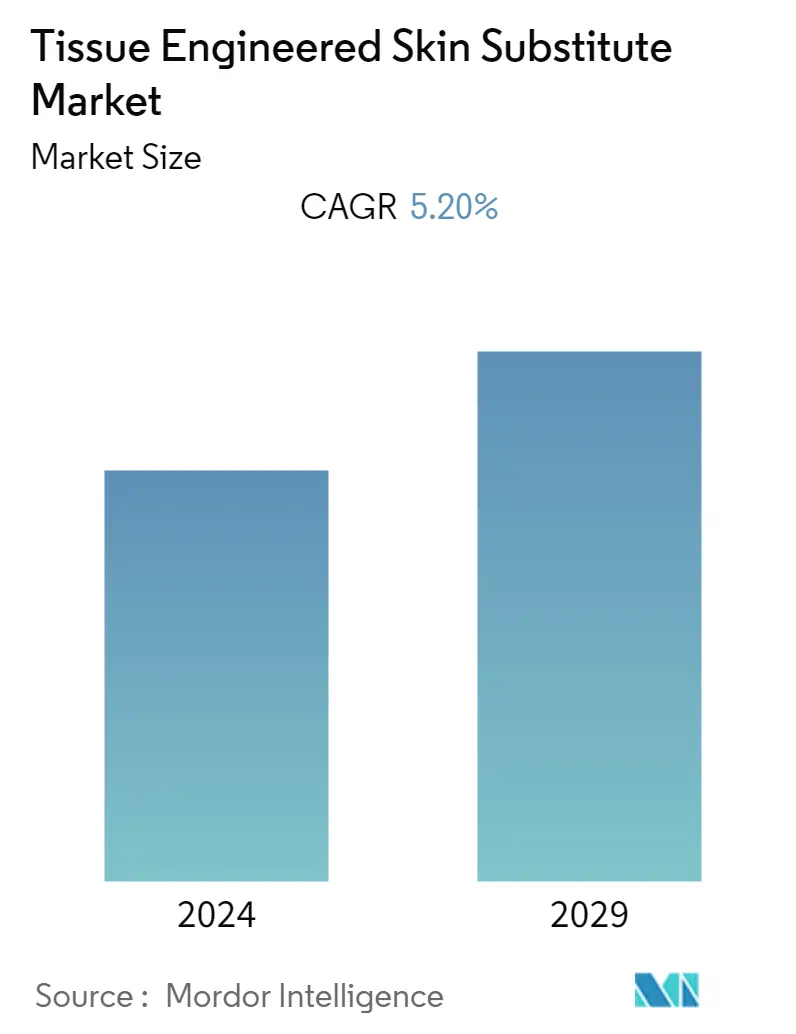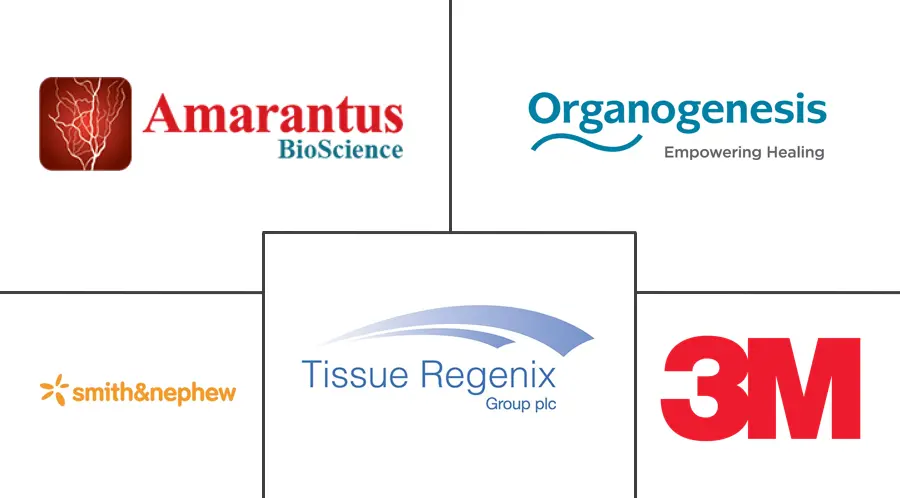Market Size of Tissue Engineered Skin Substitute Industry

| Study Period | 2019 - 2029 |
| Base Year For Estimation | 2023 |
| Forecast Data Period | 2024 - 2029 |
| CAGR | 5.20 % |
| Fastest Growing Market | Asia Pacific |
| Largest Market | North America |
Major Players
*Disclaimer: Major Players sorted in no particular order |
Tissue Engineered Skin Substitutes Market Analysis
The Tissue Engineered Skin Substitute market studied is anticipated to grow with a CAGR of nearly 5.2%, during the forecast period.
Certain factors that are driving the market growth include increasing prevalence of chronic wounds, growing burn & trauma cases, and rising focus on technological advancements.
There is also a demand for relatively cheap and available skin-replacement products that have encouraged many research groups worldwide to focus on creating biomaterials for skin substitution. The engineered tissues not only closes wounds but also stimulates the regeneration of the dermis and would provide a significant benefit in human wound healing. Moreover, the increasing prevalence of chronic diseases alongside road accidents, injuries, and trauma cases escalates the market on the global platform.
There is also an increase in funding from government and private companies for R&D of regenerative treatments and growth in the adoption of the regenerative medicine industry that is expected to drive the overall market.
Tissue Engineered Skin Substitutes Industry Segmentation
Skin substitutes are the most straightforward of the tissue-engineered organ constructs, and have been developed over many years for the testing of commercial products, therapeutics, and as models of skin biology and pathology. They are based on the ability of fibroblasts and keratinocytes to form a skin-like structure spontaneously, but have been extended by the inclusion of other cell types to provide models of the very wide range of properties displayed by intact skin. The tissue engineered skin substitute market encompasses the production of these constructs on a commercial scale, particularly for therapeutic purposes.
| By Product type | |
| Natural | |
| Synthetic |
| By Application | |
| Chronic Wounds | |
| Acute Wounds |
| By End-User | |
| Hospital and Clinic | |
| Ambulatory Surgical Center | |
| Others |
| Geography | ||||||||
| ||||||||
| ||||||||
| ||||||||
| ||||||||
|
Tissue Engineered Skin Substitute Market Size Summary
The Tissue Engineered Skin Substitute market is poised for significant growth, driven by the increasing prevalence of chronic wounds and a rising number of burn and trauma cases. Technological advancements and the demand for cost-effective skin-replacement products are further propelling market expansion. Engineered tissues play a crucial role in wound healing by not only closing wounds but also stimulating dermis regeneration, offering substantial benefits in human wound recovery. The market is also bolstered by increased funding from both government and private sectors for research and development in regenerative treatments, alongside a growing adoption of the regenerative medicine industry. The rise in lifestyle disorders, particularly diabetes, which leads to chronic wounds like foot ulcers, is a key factor expected to fuel market growth in the coming years.
North America currently leads the Tissue Engineered Skin Substitute market, attributed to the high incidence of chronic wounds, favorable reimbursement policies, and an aging population. The demand for effective therapeutics, especially for diabetes management, is on the rise in this region. Meanwhile, the Asia-Pacific region is anticipated to experience the highest growth rate, with countries like Japan, China, and India at the forefront. This growth is supported by increased focus from major industry players and government backing in emerging Asian markets. The global market is competitive, with a few major players such as 3M Company, Amarantus BioScience Holdings, and Integra LifeSciences Corporation holding substantial market shares.
Tissue Engineered Skin Substitute Market Size - Table of Contents
-
1. MARKET DYNAMICS
-
1.1 Market Overview
-
1.2 Market Drivers
-
1.2.1 Increasing Prevalence of Chronic Wounds
-
1.2.2 Growing Burn & Trauma Cases
-
1.2.3 Rising Focus on Technological Advancements
-
-
1.3 Market Restraints
-
1.3.1 Lack of Feasible Reimbursement Policies
-
1.3.2 Inability of Reproducing Skin Appendages
-
-
1.4 Porter's Five Force Analysis
-
1.4.1 Threat of New Entrants
-
1.4.2 Bargaining Power of Buyers/Consumers
-
1.4.3 Bargaining Power of Suppliers
-
1.4.4 Threat of Substitute Products
-
1.4.5 Intensity of Competitive Rivalry
-
-
-
2. MARKET SEGMENTATION
-
2.1 By Product type
-
2.1.1 Natural
-
2.1.2 Synthetic
-
-
2.2 By Application
-
2.2.1 Chronic Wounds
-
2.2.2 Acute Wounds
-
-
2.3 By End-User
-
2.3.1 Hospital and Clinic
-
2.3.2 Ambulatory Surgical Center
-
2.3.3 Others
-
-
2.4 Geography
-
2.4.1 North America
-
2.4.1.1 United States
-
2.4.1.2 Canada
-
2.4.1.3 Mexico
-
-
2.4.2 Europe
-
2.4.2.1 Germany
-
2.4.2.2 United Kingdom
-
2.4.2.3 France
-
2.4.2.4 Italy
-
2.4.2.5 Spain
-
2.4.2.6 Rest of Europe
-
-
2.4.3 Asia-Pacific
-
2.4.3.1 China
-
2.4.3.2 Japan
-
2.4.3.3 India
-
2.4.3.4 Australia
-
2.4.3.5 South Korea
-
2.4.3.6 Rest of Asia-Pacific
-
-
2.4.4 Middle-East and Africa
-
2.4.4.1 GCC
-
2.4.4.2 South Africa
-
2.4.4.3 Rest of Middle-East and Africa
-
-
2.4.5 South America
-
2.4.5.1 Brazil
-
2.4.5.2 Argentina
-
2.4.5.3 Rest of South America
-
-
-
Tissue Engineered Skin Substitute Market Size FAQs
What is the current Tissue Engineered Skin Substitute Market size?
The Tissue Engineered Skin Substitute Market is projected to register a CAGR of 5.20% during the forecast period (2024-2029)
Who are the key players in Tissue Engineered Skin Substitute Market?
Amarantus BioScience Holdings, Organogenesis Inc. , 3M Company , Smith & Nephew plc and Tissue Regenix are the major companies operating in the Tissue Engineered Skin Substitute Market.

